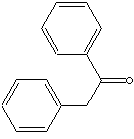|
BENZYL PHENYL KETONE
| ||
|
PRODUCT IDENTIFICATION |
||
| CAS NO | 451-40-1 |
|
| EINECS NO. | 207-193-2 | |
| FORMULA | C6H5COCH2C6H5 | |
| MOL WT. | 196.25 | |
| H.S. CODE | 2914.39 | |
|
SMILES |
| |
|
TOXICITY |
||
| SYNONYMS | Deoxybenzoin; 2-Phenylacetophenone; | |
| alpha-Phenylacetophenone; 1,2-diphenyl-Ethanone; | ||
|
CLASSIFICATION |
|
|
|
PHYSICAL AND CHEMICAL PROPERTIES |
||
| PHYSICAL STATE | white crystals | |
| MELTING POINT | 52 - 56 C | |
| BOILING POINT |
319 - 321 C | |
| SPECIFIC GRAVITY | ||
| SOLUBILITY IN WATER | poor (soluble in hot water) | |
| pH |
| |
| VAPOR DENSITY | ||
|
AUTOIGNITION |
||
|
NFPA RATINGS |
Health: 1 Flammability: 1 Reactivity: 0 | |
|
REFRACTIVE INDEX |
||
| FLASH POINT | > 110 C | |
| STABILITY | Stable under ordinary conditions | |
|
APPLICATIONS |
||
| Benzyl Phenyl Ketone is used as a solvent and an intermediate in the synthesis of pharmaceuticals and pesticides. | ||
| SALES SPECIFICATION | ||
|
APPEARANCE |
white crystals | |
| PURITY |
98.0% min | |
| MELTING POINT | 52 - 56 C | |
| TRANSPORTATION | ||
| PACKING | 25kgs in Drum | |
| HAZARD CLASS | ||
| UN NO. | ||
| OTHER INFORMATION | ||
| Hazard Symbols: XN, Risk Phrases: , Safety Phrases: 24/25-28A-37-45 | ||
| GENERAL DESCRIPTION OF KETONE | ||
|
Ketone is a class of chemical compounds contain the carbonyl group in which the
carbon atom is covalently bonded to an oxygen atom.
Carbonyl groups are:
Ketone has the general formula RCOR' where the groups R and R' may be the same or different, or incorporated into a ring (R and R' are alkyl, aryl, or heterocyclic radicals). The simplest example, R and R´ are methyl group, is acetone (also called 2-propanone, CH3COCH3) which is one of the most important ketones used in industry (low molecular weight ketones are general purpose solvents.) In the IUPAC system, the suffix -one is used to describe ketone with the numbering of the carbon atom at the end that gives the lower number. For example, CH3CH2COCH2CH2CH3 is named 3-hexanone because the whole chain contains six carbon atoms and the oxygen is connected to the third carbon from the lower number. There are aromatic ketones of which acetophenone and bezophenone are examples. Ketones can be made by the oxidation of secondary alcohols and the destructive distillation of certain salts of organic acids. In addition to as polar solvents, ketones are important intermediates in the syntheses of organic compounds such as alkoxides, hydroxyalkynes, imines, alcohols (primary, secondary as well as tertiary), acetals, thioacetals, phosphine oxides, geminal diols, hydrazones, organic sulfite and cyanohydrins. |
||

